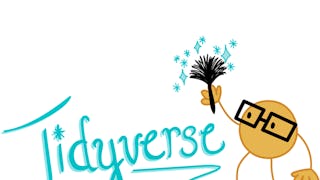Ce cours présente un ensemble puissant d'outils de science des données connu sous le nom de Tidyverse. Le Tidyverse a révolutionné la façon dont les scientifiques des données font presque tous les aspects de leur travail. Nous aborderons l'idée simple de "données bien rangées" et la manière dont cette idée sert à organiser les données pour l'analyse et la modélisation. Nous verrons également comment des données non ordonnées peuvent être transformées en données ordonnées, le cycle de vie d'un projet de science des données et l'écosystème des packages R de Tidyverse qui peuvent être utilisés pour exécuter un projet de science des données.

Cultivez votre carrière grâce à des programmes dirigés par des experts, des certificats prêts à l'emploi et des moyens d'évoluer sur 10 000 . Le tout pour 25 $US/mois, facturé annuellement. Économisez


Introduction au Tidyverse
Ce cours fait partie de Spécialisation Compétences Tidyverse pour la science des données en R



Instructeurs : Carrie Wright, PhD
4 783 déjà inscrits
Inclus avec 
(48 avis)
Expérience recommandée
Ce que vous apprendrez
Distinguer les données ordonnées des données non ordonnées
Décrire comment des données non ordonnées peuvent être transformées en données ordonnées
Décrivez l'écosystème de paquets de Tidyverse
Organiser et initialiser un projet de science des données
Compétences que vous acquerrez
- Catégorie : Analyse des Données
- Catégorie : Leadership et Management
- Catégorie : Principes de programmation
- Catégorie : Bases de données
- Catégorie : Programmation Informatique
Détails à connaître

Ajouter à votre profil LinkedIn
5 devoirs
Découvrez comment les employés des entreprises prestigieuses maîtrisent des compétences recherchées

Élaborez votre expertise du sujet
- Apprenez de nouveaux concepts auprès d'experts du secteur
- Acquérez une compréhension de base d'un sujet ou d'un outil
- Développez des compétences professionnelles avec des projets pratiques
- Obtenez un certificat professionnel partageable


Obtenez un certificat professionnel
Ajoutez cette qualification à votre profil LinkedIn ou à votre CV
Partagez-le sur les réseaux sociaux et dans votre évaluation de performance

Il y a 6 modules dans ce cours
Avant de pouvoir discuter de toutes les façons dont R facilite le travail avec des données ordonnées, nous devons d'abord nous assurer que nous savons ce que sont des données ordonnées. Les ensembles de données ordonnées sont, par conception, plus faciles à manipuler, à modéliser et à visualiser, car les principes des données ordonnées que nous aborderons dans ce cours imposent un cadre général et un ensemble cohérent de règles aux données. En fait, une citation bien connue de Hadley Wickham est que "les ensembles de données bien rangés se ressemblent tous, mais chaque ensemble de données désordonné est désordonné à sa manière" L'utilisation d'un format de données cohérent et ordonné permet de créer des outils qui fonctionnent bien dans ce cadre, ce qui simplifie en fin de compte les processus de traitement, de visualisation et d'analyse des données. Si vous commencez avec des données qui sont déjà dans un format ordonné ou si vous prenez le temps, au début d'un projet, de mettre les données dans un format ordonné, les autres étapes de votre projet de science des données seront plus faciles.
Inclus
6 lectures2 devoirs
S'il est important de discuter de ce que sont les données ordonnées et de ce à quoi elles ressemblent, c'est parce que dans le monde, la plupart des données ne sont pas ordonnées. Si ce n'est pas vous qui saisissez les données, mais quelqu'un d'autre qui vous les remet pour réaliser un projet, le plus souvent, ces données ne seront pas ordonnées. Les données non ordonnées sont souvent appelées simplement "données désordonnées". Pour pouvoir travailler facilement avec ces données, vous devez les mettre en forme. Cela signifie que vous devez reconnaître les données désordonnées et comprendre comment les mettre en forme. Les problèmes courants suivants, observés dans les ensembles de données désordonnées, sont à nouveau tirés de l'article de Hadley Wickham sur les données ordonnées (http://vita.had.co.nz/papers/tidy-data.pdf). Après un bref rappel de chaque problème courant, nous examinerons quelques ensembles de données désordonnées. Nous aborderons enfin les concepts de rangement des données désordonnées, mais nous ne ferons pas encore d'exercices pratiques. C'est pour bientôt !
Inclus
3 lectures1 devoir
Avec une solide compréhension des données bien rangées et de la façon dont les données bien rangées s'intègrent dans le cycle de vie de la science des données, nous allons prendre un peu de temps pour vous présenter les paquets tidyverse et tidyverse-adjacent que nous allons enseigner et utiliser tout au long de cette spécialisation. L'ensemble de ces packages constitue ce que nous appelons l'écosystème tidyverse. Le but du reste de ce cours n'est pas que vous compreniez comment utiliser chacun de ces paquets (ce sera bientôt le cas !), mais plutôt de vous aider à vous familiariser avec quels paquets correspondent à quelle partie du cycle de vie de la science des données. Notez que les paquets officiels de tidyverse ci-dessous sont en gras. Tous les autres paquets sont adjacents à tidyverse, ce qui signifie qu'ils suivent les mêmes conventions que les paquets officiels de tidyverse et qu'ils fonctionnent bien dans le cadre et la structure tidy de l'analyse des données.
Inclus
5 lectures
Les projets de science des données varient considérablement et il peut donc être difficile de donner des règles universelles sur la façon dont ils devraient être organisés. Cependant, il existe quelques façons d'organiser les projets qui sont généralement utiles. En particulier, presque tous les projets doivent gérer des fichiers de différentes sortes - fichiers de données, fichiers de code, fichiers de sortie, etc. Cette section traite du fonctionnement des fichiers et de la manière dont les projets peuvent être organisés et personnalisés.
Inclus
6 lectures2 devoirs
Tout au long de cette spécialisation, nous allons utiliser un certain nombre d'études de cas provenant des Open Case Studies pour démontrer les concepts introduits dans le cours. Nous utiliserons généralement les mêmes études de cas tout au long de la spécialisation, assurant ainsi une continuité qui vous permettra de vous concentrer sur les concepts et les compétences enseignés (plutôt que sur le contexte) tout en travaillant avec des données intéressantes. Ces études de cas visent à répondre à une question de santé publique et utilisent toutes des données réelles.
Inclus
2 lectures2 laboratoires non notés
Ce projet vous permettra de créer un nouveau projet et d'organiser les fichiers nécessaires à une future analyse de données
Inclus
1 évaluation par les pairs
Instructeurs



Offert par
Recommandé si vous êtes intéressé(e) par Analyse des Données

Johns Hopkins University

Johns Hopkins University

University of Colorado Boulder

University of Colorado Boulder
Pour quelles raisons les étudiants sur Coursera nous choisissent-ils pour leur carrière ?




Avis des étudiants
48 avis
- 5 stars
70,83 %
- 4 stars
14,58 %
- 3 stars
4,16 %
- 2 stars
2,08 %
- 1 star
8,33 %
Affichage de 3 sur 48
Révisé le 17 avr. 2024
The course is a breeze to follow because it aligns seamlessly with the book. As such, rather than watching videos, you get to read the book; it's really a convenient approach.
Bravo!
Révisé le 30 oct. 2022
Covers really important concepts and procedures for managing data science projects. Very helpful.

Ouvrez de nouvelles portes avec Coursera Plus
Accès illimité à 10,000+ cours de niveau international, projets pratiques et programmes de certification prêts à l'emploi - tous inclus dans votre abonnement.
Faites progresser votre carrière avec un diplôme en ligne
Obtenez un diplôme auprès d’universités de renommée mondiale - 100 % en ligne
Rejoignez plus de 3 400 entreprises mondiales qui ont choisi Coursera pour les affaires
Améliorez les compétences de vos employés pour exceller dans l’économie numérique
Foire Aux Questions
L'accès aux cours et aux devoirs dépend de votre type d'inscription. Si vous suivez un cours en mode audit, vous pourrez consulter gratuitement la plupart des supports de cours. Pour accéder aux devoirs notés et obtenir un certificat, vous devrez acheter l'expérience de certificat, pendant ou après votre audit. Si vous ne voyez pas l'option d'audit :
Il se peut que le cours ne propose pas d'option d'audit. Vous pouvez essayer un essai gratuit ou demander une aide financière.
Le cours peut proposer l'option "Cours complet, pas de certificat" à la place. Cette option vous permet de consulter tous les supports de cours, de soumettre les évaluations requises et d'obtenir une note finale. Cela signifie également que vous ne pourrez pas acheter un certificat d'expérience.
Lorsque vous vous inscrivez au cours, vous avez accès à tous les cours de la Specializations, et vous obtenez un certificat lorsque vous terminez le travail. Votre certificat électronique sera ajouté à votre page de réalisations - de là, vous pouvez imprimer votre certificat ou l'ajouter à votre profil LinkedIn. Si vous souhaitez uniquement lire et visualiser le contenu du cours, vous pouvez auditer le cours gratuitement.
Si vous vous êtes abonné, vous bénéficiez d'une période d'essai gratuite de 7 jours pendant laquelle vous pouvez annuler votre abonnement sans pénalité. Après cette période, nous ne remboursons pas, mais vous pouvez résilier votre abonnement à tout moment. Consultez notre politique de remboursement complète.
Plus de questions
Aide financière disponible,


